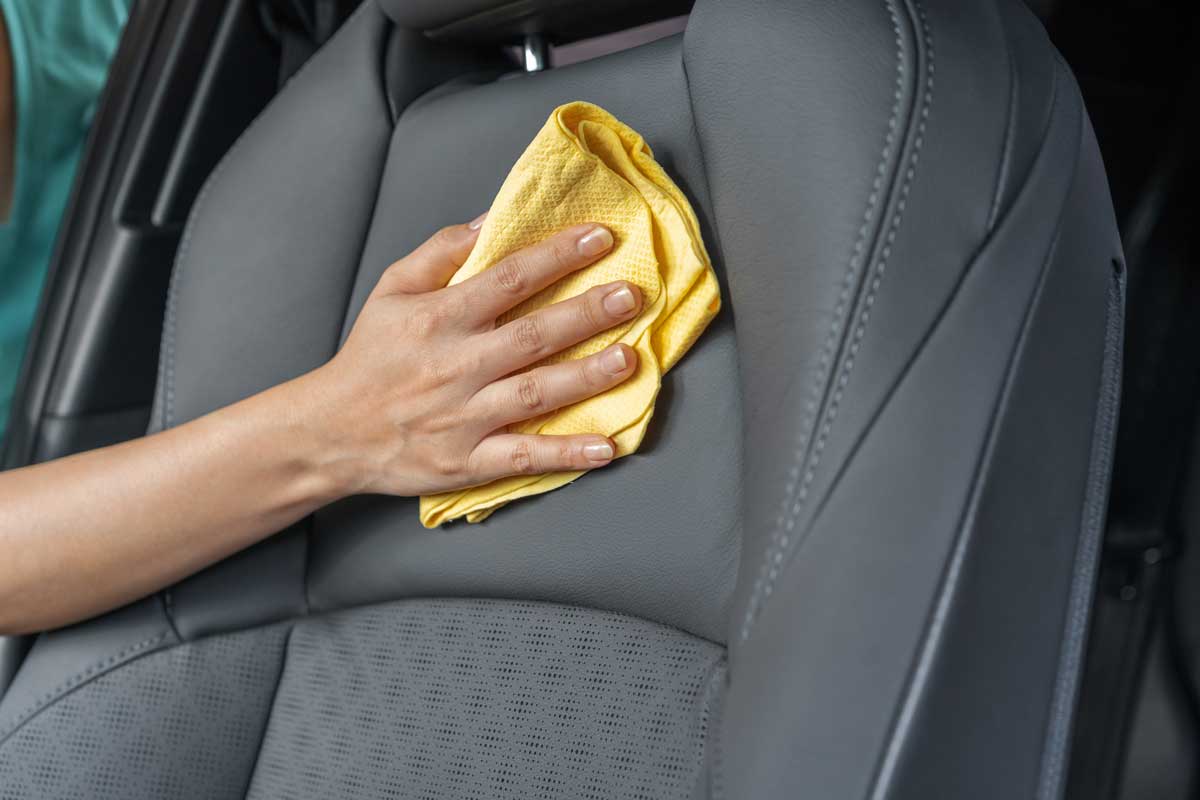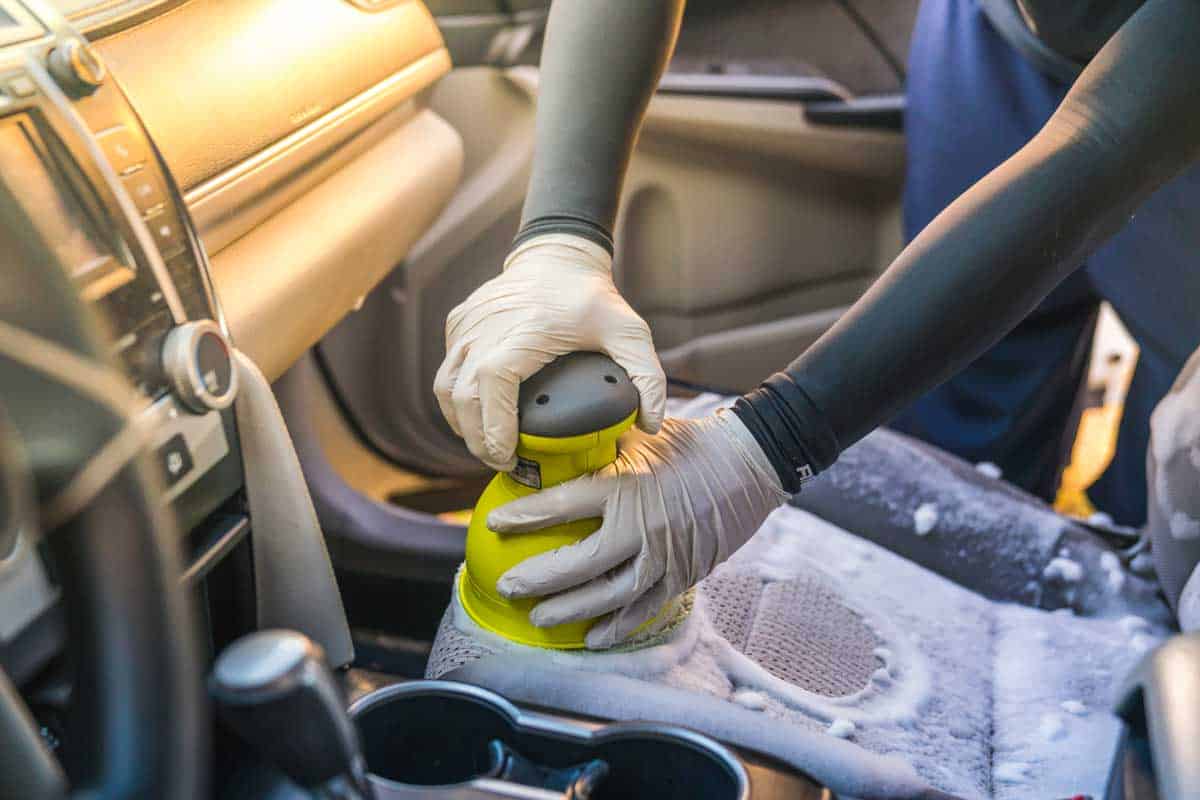 The best way to protect leather from the sun’s scorching rays is to apply a high-quality conditioner regularly. Although there are many fine synthetic brands on the market, some car owners prefer making all-natural conditioners. If you’re interested in natural conditioners for your car’s leather upholstery, then you’ve got to check out the research we’ve done on this topic.
The best way to protect leather from the sun’s scorching rays is to apply a high-quality conditioner regularly. Although there are many fine synthetic brands on the market, some car owners prefer making all-natural conditioners. If you’re interested in natural conditioners for your car’s leather upholstery, then you’ve got to check out the research we’ve done on this topic.
Here are a few of the most popular all-natural leather conditioners you could try at home:
- Melted beeswax, coconut oil, and sweet almond oil
- Baby soap and water
- Vaseline
- Linseed oil, vinegar, and water
For more detailed information on detailing your leather seats naturally, be sure to read all of the tips listed below.
How To Make And Use Natural Leather Conditioners
In this first section, we’ll elaborate on the DIY leather conditioners we mentioned in the introduction. You’ll also learn how to properly apply these conditioners to your car’s leather seats.
First Off, Don’t Forget Your Microfiber Towel!
Before you try any of the conditioners listed in this article, please be sure you have a clean, car-approved microfiber towel. Microfiber is the only material gentle enough to clean leather surfaces thoroughly without scratching them.
Always apply a tiny dab of conditioner to one side of your microfiber towel and then rub it into your leather seats. Once you’ve covered your entire seat, let the conditioner sit for a few minutes before wiping it off with the dry side of the towel.
Chemical Guys now puts out a popular set of microfiber towels designed for cars.
Click here to see more on Amazon.
1. Make A Brilliant Beeswax Conditioner
One of the most popular DIY leather conditioners involves mixing melted beeswax, coconut oil, and sweet almond oil. Proponents of this conditioner claim the beeswax and coconut oil help naturally condition leather while the sweet almond oil softens the interior.
There are loads of different recipes for this mix online, but here’s a simple method you can follow:
- Combine equal parts beeswax and coconut oil in a microwave-safe two-cup Pyrex measuring jar.
- Place the Pyrex jar in the microwave for about 30 seconds and stir the mixture with a wooden stirring stick.
- Repeat the second step about four to five times until the mixture has turned to a liquid.
- Be sure to stop the microwave if you notice the beeswax mixture boiling or bubbling.
- While stirring your liquid beeswax mixture, add double the amount of sweet almond oil.
- Transfer the mixture to a clean tin and wait a few hours for it to harden.
Once your beeswax conditioner has solidified a bit, you can take off a dab and apply it to leather surfaces. After letting the beeswax sit for a few minutes, wipe away the conditioner with a clean microfiber towel.
As already mentioned, there are many variations on this beeswax conditioner. For instance, some people add castor oil while others put in a pinch of rubbing alcohol. If you’re looking for inspiration, then you can check out this thorough guide to making a perfect beeswax conditioner.
Anyone interested in purchasing 100 percent pure beeswax online should take a look at this product.
Click here to see more on Amazon.
2. Use Baby Soap For A Safe Sheen
Most soaps are way too abrasive to clean or condition leather safely. You can, however, give your leather seats a fine shine with a bit of natural baby soap.
Since baby soap is, well, made for babies, it’s far gentler on leather surfaces than other products. All you have to do is mix a teaspoon of baby soap in about a cup of lukewarm water. You could also add a few drops of vinegar to help with degreasing.
When your mixture is well combined, dab a bit of the liquid onto a towel and apply it to your car seats. For the best results, let these seats air dry.
When shopping for baby soap, please pick a product without any harsh chemical additives or colors. If possible, look for soaps that have a bit of soothing coconut oil like this one.
Click here to see more on Amazon.
3. Spread Some Vaseline On Your Chapped Seats
Yes, some people use Vaseline to condition their leather upholstery. Although it might sound strange, many car enthusiasts swear this inexpensive DIY leather conditioner.
All you have to do is spread a thin layer of Vaseline over your car’s seats until you notice a nice shine. Let the Vaseline sit for a few minutes before wiping it away with a clean towel.
You can easily pick up a few bottles of Vaseline online nowadays.
Click here to see more on Amazon.
4. Make A Linseed Oil Mixture For Added Luster
Although linseed oil is often used for polishing wood, you could use it to make a surprisingly effective leather conditioner. After mixing linseed oil with water and vinegar, pour a tiny bit on your microfiber towel and apply it to your seats. If you have the time, it’s best to let this mixture air dry.
You can learn more about using linseed oil as a conditioner in this guide: How To Clean Leather Car Seats? [Ste-By-Step Guide]
What Is The Best Natural Leather Conditioner?

Any of the leather conditioners listed above will work fine, but many people recommend the beeswax option. Although it takes more time to prepare, the mix of the beeswax, coconut oil, and sweet almond oil lasts a long time and provides a powerful protective layer.
Finding the best natural leather conditioner for you, however, will require a bit of experimentation. Everyone has unique preferences, so be sure to try a few methods and see what works for you.
How Often Do You Need To Condition Leather Car Seats?
For general maintenance, it’s a good idea to condition your car’s leather seats at least once every three months. If you live in an area that gets a lot of sunlight, then you might want to condition your leather interior once every two months to combat UV exposure.
What’s The Best Brand Of Leather Conditioner?
Just like with natural leather conditioners, choosing “the best” name-brand conditioner is a subjective matter. There are, however, a few names that stand out in today’s market.
For instance, one of the hottest names in the world of leather conditioners is a product called Leather Honey.
Click here to see more on Amazon.
Another popular option worth looking into is Meguiar’s Leather Cleaner & Conditioner.
Click here to see more on Amazon.
Can Leather Conditioners Remove Stuck Gum?
In theory, leather seats with a coating of conditioner should be resistant to chewing gum gunk. If a wad of gum sticks to a car seat, however, you shouldn’t use a leather conditioner to get it off.
For expert tips on removing chewing gum from car seats, we encourage you to read through this post: How To Get Gum Off Your Car Seat. After you’ve successfully removed your gum, it’s a good idea to wipe the affected area with your preferred leather conditioner.
Watch Out For These Pseudo DIY Leather Conditioners
Now that you know what leather conditioners work, let’s go over a few you should avoid. Below, you’ll find two trendy “natural conditioners” that could make your car look worse.
Is Mayonnaise A Leather Conditioner?
Yes, you read that subtitle right. Some people swear by using mayonnaise to condition their leather…but does it work?
According to experts, you should never spread mayo over your leather seats. Not only will mayo make your leather upholstery smell funky, but it also won’t give you the stunning sheen you're after.
Is Olive Oil A Good Leather Conditioner?
Another condiment that has gained a lot of attention as a natural conditioner is olive oil. Although this product will give your leather seats a nice sheen initially, it isn’t a great long-term solution.
Indeed, many people who use olive oil and vinegar soon notice unsightly spots on their leather seats. Plus, depending on how much olive oil you apply, it might leave a strong peppery scent behind.
Condition Your Leather Often For A Classy Sheen

Regularly conditioning your leather interior will keep your seats looking fresh even after years of use. Just because you apply conditioner, however, doesn’t mean your car is immune to upholstery issues. We strongly encourage you to read through our guide on how to repair leather seats so that you can prepare for the worst-case scenario.






